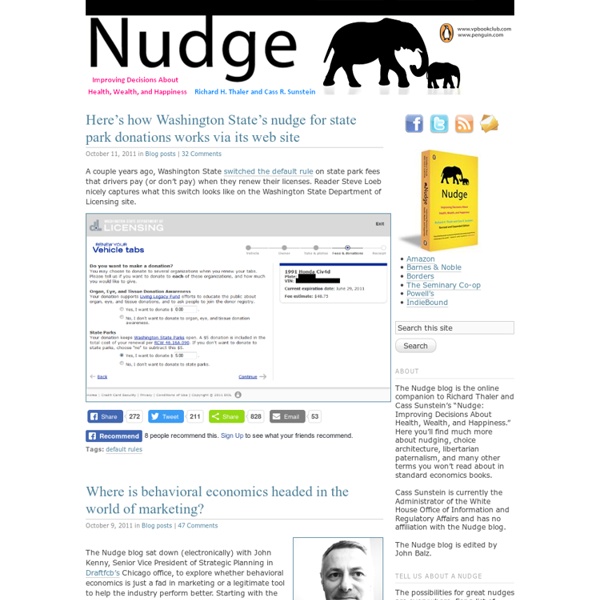



On habits and how to change them This week I’m at the Behavior, Energy, and Climate Change Conference in Sacramento, Calif. Climate hawks and policy wonks spend a lot of time thinking about technology and regulation, but not nearly enough thinking about behavior and human motivation. Building a clean energy future will require not just concentrated solar and carbon caps but big changes in how people and societies do things. For insights on motivating change, let’s turn to philosopher William James: Everyone has certain behaviors they repeat over and over again, causing the same unwelcome effects. In addition to being a wicked bitchin’ philosopher, James was a keen student of human nature. This is easy to forget. Our naive self-image is that we decide what’s right and wrong based on our beliefs and values, and act accordingly. Habits are formed on the basis of nature, nurture, and circumstance, but only very rarely conscious thought. It’s difficult for many people to accept this. Aaaanyway … so what?
SCVNGR’s Secret Game Mechanics Playdeck Some companies keep a playbook of product tips, tricks and trade secrets. Zynga has an internal playbook, for instance, that is a collection of “concepts, techniques, know-how and best practices for developing successful and distinctive social games”. Zynga’s playbook has entered the realm of legend and was even the subject of a lawsuit. SCVNGR, which makes a mobile game with real-world challenges, has a playdeck. It is a deck of cards listing nearly 50 different game mechanics that can be mixed and matched to create the foundation for different types of games. Rght now, that should be a lot of people. SCVNGR’s playdeck tries to break down the game mechanics into their constituent parts. SCVNGR Game Dynamics Playdeck Guide To This Document: This list is a collection of game dynamics terms, game dynamics theories that are interesting, useful and potentially applicable to your work here at SCVNGR. 1. Definition: A virtual or physical representation of having accomplished something. 2. 3.
Book Summary: Yes! 50 Scientifically Proven Ways to be Persuasive Yes! 50 Scientifically Proven Ways To Be Persuasive This book is an attempt to focus on persuasion as a science rather than an art. It relies on a significant body of research to compile this list. 1) Social Proof – People look outside themselves to justify their actions. 2) More individualized messages get greater results. 3) Social proof can backfire if you are showing that the wrong course of action is popular. 4) People who deviate from the average will move toward the average. 5) For those acting in a socially desirable way, there needs to be praise or positive reinforcement of the good behavior. 6) Too many choices overwhelm people unless people are already clear about their options. 7) When giving a free gift with an item, the value of the free item declines in the mind of the purchaser. 8 )When multiple products are offered, the middle item is often selected as the compromise approach. 10) Reciprocation is a social norm and can be used effectively to persuade. Be Sociable, Share!
Association for Applied Sport Psychology How to Nudge Consumers to Be Environmentally Friendly A real-life experiment in engineering green behavior unfolded recently in the nation's capital. Washington, D.C., imposed a five-cent tax on every disposable bag, paper or plastic, handed out at any retail outlet in the city that sells food, candy or liquor, effective Jan 1. But more important than the extra cost was something more subtle: No one got bags automatically anymore. Instead, shoppers had to ask for them—right in front of their fellow customers. The result? Retail outlets that typically use 68 million disposable bags per quarter handed out 11 million bags in the first quarter of this year and fewer than 13 million bags in the second quarter, according to the district's Office of Tax and Revenue. District Councilman Tommy Wells doesn't believe it is the nominal cost that's keeping shoppers from using bags, but rather the expectation—made clear in a very public way in every transaction—that they could make do without. It's not easy. The magic ingredient: Peer pressure. Ms.
Ehrenberg-Bass Institute Lucid | Building Dashboard Competitions Go head-to-head in energy and water use reduction competitions between buildings, floors, and departments. Budgets Track success toward meeting a monthly budget with colorful calendar views and pertinent daily summaries. Discussions Make public announcements, strategize about reduction efforts, and share best practices with live discussion feeds. Commitments Call on individuals to publicly commit to energy and water conservation actions in their buildings and on Facebook. Community comparisons Grade your building against the best and worst performers, and see where your building stands among its neighbors. Event tagging Create a continuous log of building improvements, energy efficiency upgrades, and community activities.
Manilla andrewdarnton.co.uk NationalField | Measure Change How Elastic Emergency Loans Work Handle surprise medical bills and car repairs. Pay a bill on time to avoid service disconnection. Avoid overdraft fees and late fees. Apply now in 3 minutes using our secure online application. It only takes a few seconds after you submit your application to find out how much cash you can get. Draw an amount up to your limit to transfer to your checking account as soon as the next business day. With Mobiloans, you get a line of credit, but the money you draw goes to your checking account. New customers can receive lines of credit between $200 and $1,000. Instead of daily interest like a credit card, with Mobiloans you pay only a cash advance fee for every $20 you draw. If you need more time to repay your Mobiloans Credit, a Fixed Finance Charge will be applied to your account each billing cycle you have an unpaid balance. Don’t worry about another bill. Payment Schedule. Learn more about AutoPay Source: Consumer Reports, Bank accounts – More fees are coming.
HOME CROP Influencer: The New Science of Leading Change